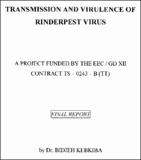| dc.description.abstract | The project entitled 'Transmission and virulence of rinderpest virus' has been approved and
financed by the European Economic Community, General Direction XII (EEC-GD XII — STD2).
It comprises a total of four laboratories:
- Institute for Animal Health, Pirbright Laboratory, Great Britain;
- Laboratoire de virologie et d'immunologie, [Virology and immunology laboratory] of the
Faculty of Veterinary Medicine of the Universite de Liege, Belgium;
- Institut d'elevage et de medecine veterinaire (IEMVT), [Livestock and Veterinary Medicine
Institute], Maison-Alfort, France;
- Laboratoire de recherches veterinaires et zootechniques de Farcha, [Laboratory for veterinary
and Zootechnical Research of Farcha], N'Djamena, Tchad.
The purpose of this project is to study some rinderpest's viral strains of different pathogenecity,
which will firstly give us the opportunity to understand the basics ofpoSe variations, to assess if
this phenomenon can be associated to the virus's persistence and, finally, to bring to the fore
factors, badly understood until then, which influence the virus's pathogenecity. Secondly, the
following aspects of those strains will be studied:
- genes sequences of their F and H proteins;
- incubation period;
- duration of the virus's excretion in case of an infection;
- minimum time required for an infecting contact;
- number of animals infected, over a given period of time, by an animal excreting the virus.
The results obtained in the course of those experiments will lead to the development of a
mathematical model of rinderpest infection.
Rinderpest constitutes a disease which is acute, febrile, inoculable, very contagious and mainly
transmissible through direct contact. It affects almost all species belonging to the Artiodactyles
family among which ruminants and swines are the most sensitive (PLOWRIGHT, 1968). With
rabies, it is the longest known affection and perhaps the most deadly for cattle. It is still affecting (ikAfrica, India and the Near East (PLOWRIGHT, 1985). The disease is known since the fifth
century, but it is in 1902 that NICOLE and BEY demonstrated the filterability of the virus.
As a result of a virus belonging to the Paramyxoviridae family, of the morbillivirus type, this
disease is characterised by a more or less apparent typhic condition, an inflammation of mucous
membranes, that of the digestive tractus in particular, with erosion and necrosis.
Although there is only one antigenic type of rinderpest virus, whatever its geographic origin,
many isolated strains fundamentally differ over the world because of its level of virulence. As a
result, they were coarsely divided into three categories (TAYLOR, 1986). The first category
comprises those called hypervirulent which cause 100% mortality in animals. Strains of the
second category have an average virulence resulting in a mortality rate of 33%. The third one
encompasses hypovirulent strains leading to a mortality rate from 0 to 5% which result however
in abortive forms, with truncated clinical expression.
The duration of the incubation period, the infection and the mortality noticeably vary according
to the virus's virulence, the receptivity or the natural resistance of animals, the intensity of
contacts, the number of viral units excreted by an animal and finally, to a lesser extent, to the
environment in which contact is made. Indeed, those factors play a crucial role in the
transmission speed of the virus from one animal to another and, consequently, influence the
spread of the disease in a given population.
The existence of atypical forms, indeed asymptomatic (subclinical) makes the possible
dissemination of the virus in herds even more dreadful and, by way of consequence, renders the
clinical diagnosis almost impossible. This complicates even more the epidemiological study of
the disease (PROVOST et al., 1973).
Several in vivo experiments in relation to the pathogenic power of isolated strains were
undertaken (COOPER, 1932; PROVOST, 1958; ROBSON et al., 1959; PLOVVRIGHT, 1963,
1964; LIESS et al., 1964; PROVOST, 1972; TAYLOR et al., 1965, 1986). But those results are
fragmentary and only provide information on the isolated virus.
To date, there is no information in literature about the compared study of rinderpest virus/
strains of different pathogenecity in the transmission through close contact over variable periods
of time.
The part played by the laboratory of Farcha in this project is to achieve a compared study of three
rinderpest virus strains of variable virulence in sensitive animals in order to address the
abovementioned problems. Samplings and data are collected with a view to forward them to
European laboratories which are partners involved in the said project. | |
